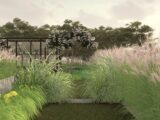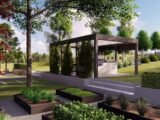Have you ever wondered why some plants do better than others? The answer could be in how much sunlight they get. It’s key to know a plant’s sunlight requirements for good gardening. But, figuring out what all the terms on plant labels mean can be tricky. Luckily, there are standards now that make understanding plant light needs easier. By learning a few important words, you can pick the best plants for where you live.
All plants need sunlight to grow, but each one might need different light intensity and time in the sun. This guide will show you the difference between shade vs sun plants. It’ll also explore how photosynthesis light requirements work. Whether you’re making an indoor paradise or a lively outdoor garden, managing light well is crucial. It helps your plants reach their full potential.
But do you understand the need for different light duration for plants inside and outside? And what about growing plants under artificial light? This article will answer these questions. It will help you become a better gardener and take your skills to the next level.
Understanding Sunlight Terminology for Plants
Full sun means plants are in bright, sunny spots all day. Many full sun plants love these conditions from sunrise to sunset. Others might enjoy a bit of shade. If a plant can handle a lot of heat and is good in full sun, it will likely thrive in strong summer sun. This is also true for plants with silver or gray leaves. But, some plants prefer cooler spots. So, always consider your local climate and the plant’s label advice.
Part Sun and Part Shade
Part sun and part shade seem alike, but there’s a key difference. Plants needing part sun or part shade do best with light that’s not too intense. They might enjoy filtered sunlight most of the day, or a bit of direct sun in the morning or afternoon. Part shade plants, however, can’t handle the strong sun especially in the afternoon. They need a break during the hottest times. On the other hand, part sun plants are fine with a bit more sunlight.
Full Shade
Shade plants can range from those under the northern house side to the deep shade under trees. Some plants, like ferns, can’t handle too much sun. They do best in filtered light. This type of light, also known as dappled shade, is great. It opens up a lot of gardening possibilities. Even full shade plants may get some direct sun in the cooler parts of the day, but they avoid the sun at noon.
Sunlight Requirements for Plant Growth
The sun is like a battery for plants, giving them the power they need to grow. This process is known as photosynthesis. Through it, plants turn light energy, carbon dioxide, and water into glucose. Glucose is the fuel for plant metabolic processes and growth.
The Importance of Sunlight for Photosynthesis
Photosynthesis is key for plants to live, turning sunlight energy into food. If they don’t get enough sunlight, they can’t make glucose. Without this food, plant growth and development stop.
Factors Affecting Sunlight Needs
Many things influence how much sunlight a plant needs. This includes the climate, soil, and if there’s enough air moving around. Plants in hot, dry places might need shade. But those in cooler spots can enjoy the sun more.
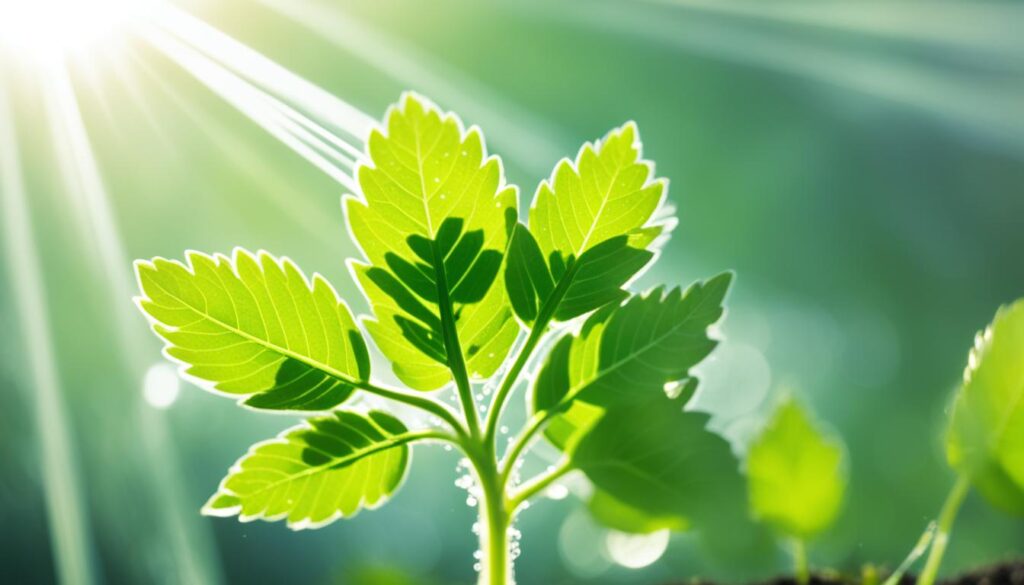
sunlight requirements for plants
Most plants need about six hours of direct sunlight to grow well. This is often called full sun. Some shade plants, though, can still grow beautifully in less sunlight. This allows you to have a vibrant garden no matter how much sun your yard gets.
It’s important to know the sunlight needs of your plants. Make sure to choose plants that match the light conditions in your garden. This will help you grow a garden that flourishes.
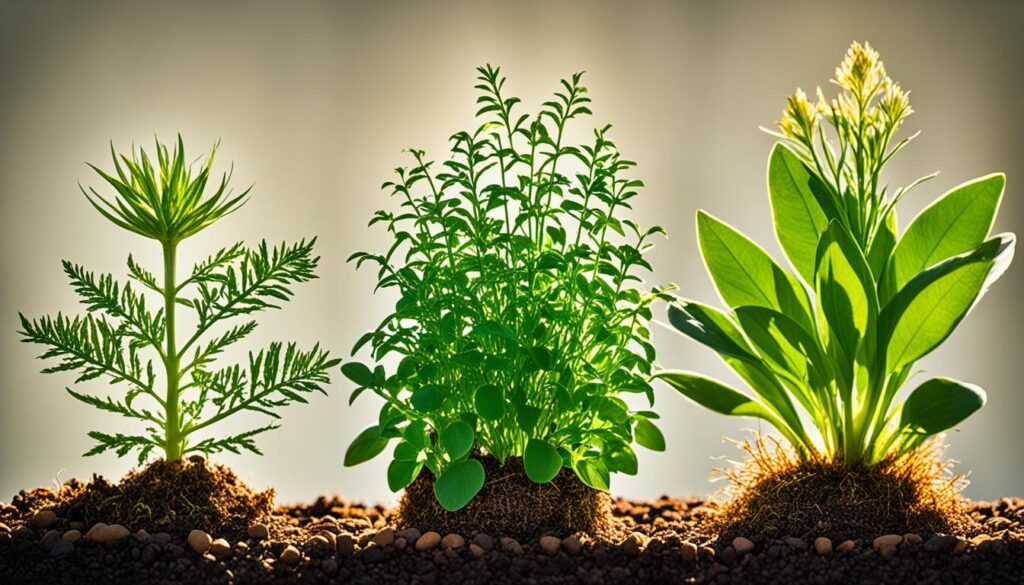
Assessing Your Garden’s Light Patterns
Creating a garden journal is a smart way to track your yard’s sunlight. Note the light patterns every hour. Pay attention to where shadows are and for how long they last. Remember, things like trees growing leaves can change the light conditions a lot.
Using a Garden Journal
Use tracing paper to make a light map of your yard. Outline your garden and then draw light and shade patterns at different times. Start a few hours after sunrise and keep marking where light and shade fall. Putting these pages together shows you how the sunlight hits your garden.
Creating a Light Map
By putting these pages together, you’ll get a clear view of the sun and shade patterns in your garden. This info will help a lot when you’re picking out plants for your garden. It shows the different light conditions in your outdoor space.
Full Sun Plants
Many annuals love the full sun. They need 6 hours of direct sunlight daily to grow well. For instance, tomatoes, squash, coneflowers, and black-eyed Susans are great choices. They can handle the afternoon sun’s intense heat and light.
Perennials and wildflowers also do well in sunny spots. Plants like Echinacea and Rudbeckia, as well as those with silver or gray leaves, thrive. It’s best to plant these full sun plants on the southern or western side of your garden. This way, they get plenty of light.
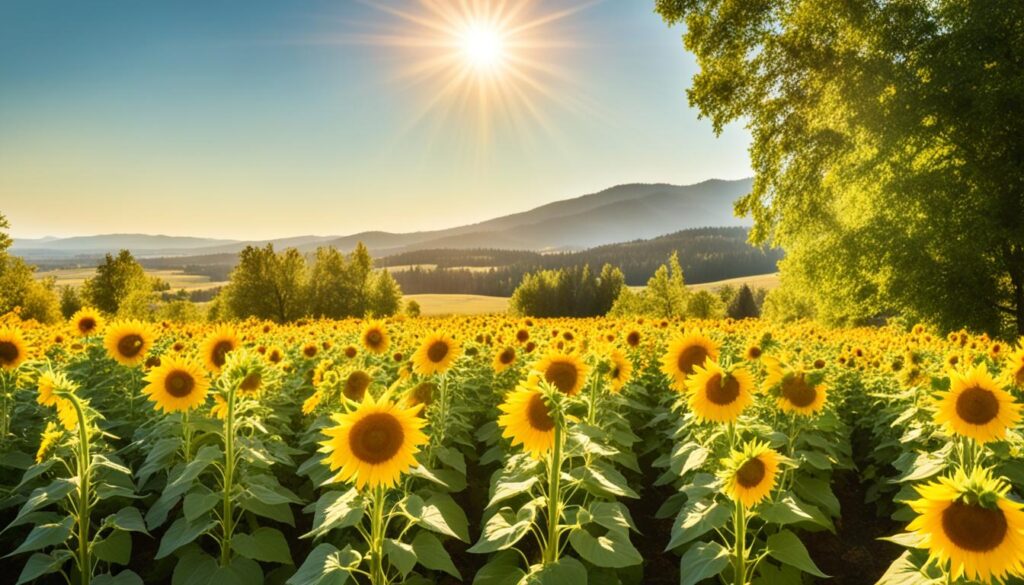
Part Sun/Part Shade Plants
Plants that like part sun or shade need 3-to-6 hours of direct sunlight. They’re sensitive to strong afternoon sun and heat. They thrive in areas with morning sun and afternoon shade.
Flowers for Partial Sun Conditions
Hyssop and Aster are good examples of these plants. They do well in spots where light comes through trees or structures.
Edible Plants for Partial Shade
Broccoli loves the sun but can bolt in hot afternoons. Grow it where it gets morning sun but not the hottest afternoon rays. Mulch the soil also. This helps it grow well. Leafy greens and other cool-season crops do well with afternoon shade too.
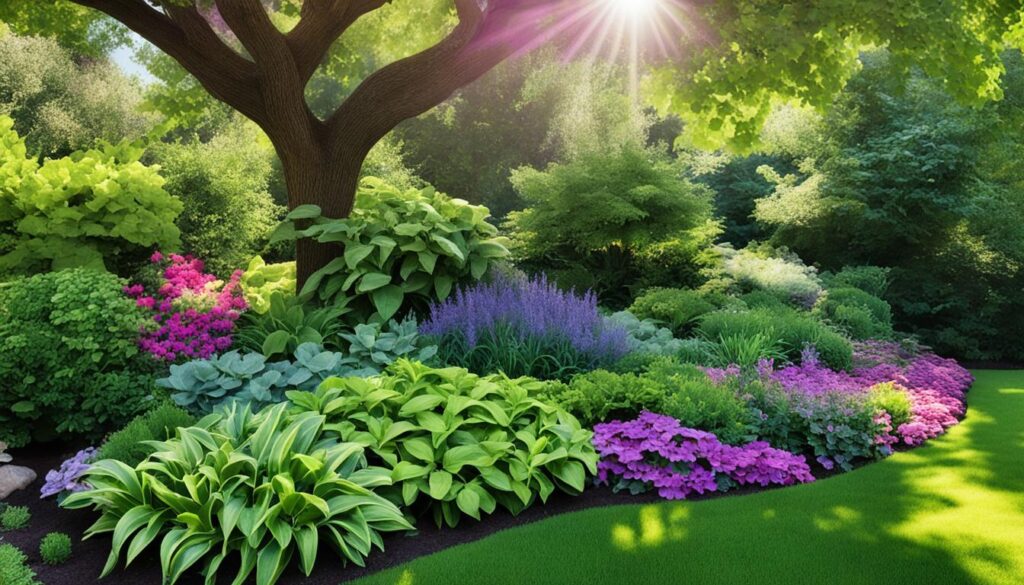
Dappled Sun Plants
«Dappled sun» describes sunlight that makes its way through a tree’s leaves. It’s less light than «partial shade». Plants that grow well in dappled sun are often found under trees in woodland areas. They’re used to the changing, soft light that comes through the leaves above. For instance, Daylilies are great examples of plants that love different light levels.
Understory Species
Dappled shade plants like ferns and woodland plants are specialists. They live under trees where light trickles through. These understory species know how to make the most of sparse sunlight. Their adaptability shows in their unique shapes and colors.
Full Shade Plants
Full shade doesn’t mean no light. It’s for plants that need less than 3 hours of sun. These full shade plants thrive on the north side of buildings or under thick tree canopies. Ferns and leafy greens like kale do well with less light.
Ferns and Leafy Greens
Ferns love areas with little light. They bring a delicate, lacy feel to shady gardens. Leafy greens such as spinach and kale are also perfect for these conditions.
Full shade plants might not grow as much as those in the sun. But, they can still make your garden lush. Choose ferns and leafy greens carefully. In no time, you’ll have a beautiful, productive shady garden.
Optimizing Light Conditions
If your garden gets too much or too little light, you can tweak it. By trimming the lower tree branches, you let more light reach the ground. You can also thin out thick shrubs and trees to boost light in shadowed spots. These steps tailor the light settings to what your plants need.
Pruning Trees and Shrubs
Pruning helps a lot with canopy thinning and giving your garden more light. When you cut back lower branches, more sunlight gets through. This is great for plants that love the sun but are in the shade.
Using Trellises and Vines
Adding things like trellises and vines can control how much sunlight plants get. For example, setting a trellis near a wall and growing vines on it creates a bit of shade underneath. It’s perfect for places that bathe in the afternoon sun. Using vertical gardening lets you fine-tune the light for your plants.
Adapting to Local Conditions
A plant’s need for light changes based on climate and growing conditions. For example, in the hot South, some plants do better with afternoon shade. But in the cloudy Pacific Northwest, these very same plants might enjoy sunnier spots. It’s crucial to match your garden’s plants with its unique climate to help them grow.
The light and microclimates in your area can really impact plant health. By observing light patterns and experimenting with plant placements, you can find the best sun exposure for your garden. This work of fitting plants to their local home helps your landscape flourish.
Troubleshooting Light Issues
If a plant looks unhappy, light could be the issue. Signs are fewer flowers, small size, or stalks stretching out. This means your plant doesn’t have the right amount of light.
To fix this, think about moving the plant. Choose a new space with better light. Study your garden’s light areas. Then, move plants to where they’ll get what they need. Plants can often change to fit new spots, so it’s okay to try and see what works best.
To help your plants do well, watch them and make changes. Make sure they are where they can get good light. Troubleshooting your garden’s light problems can lead to a beautiful, healthy garden.


